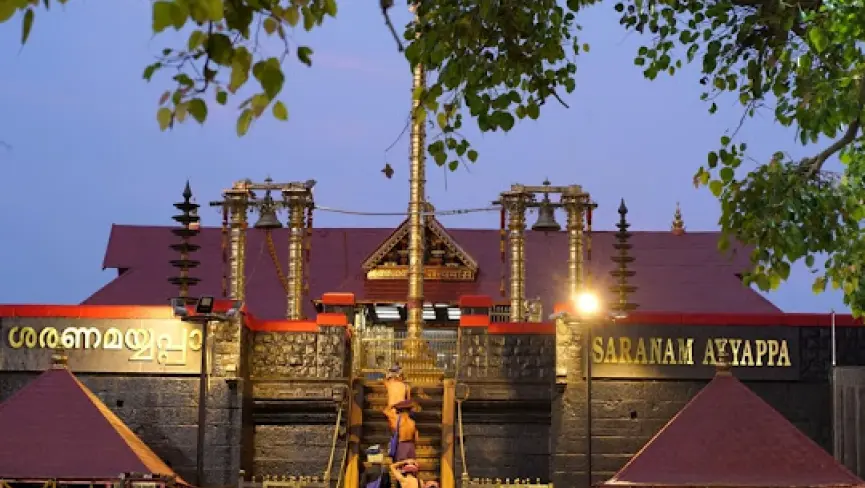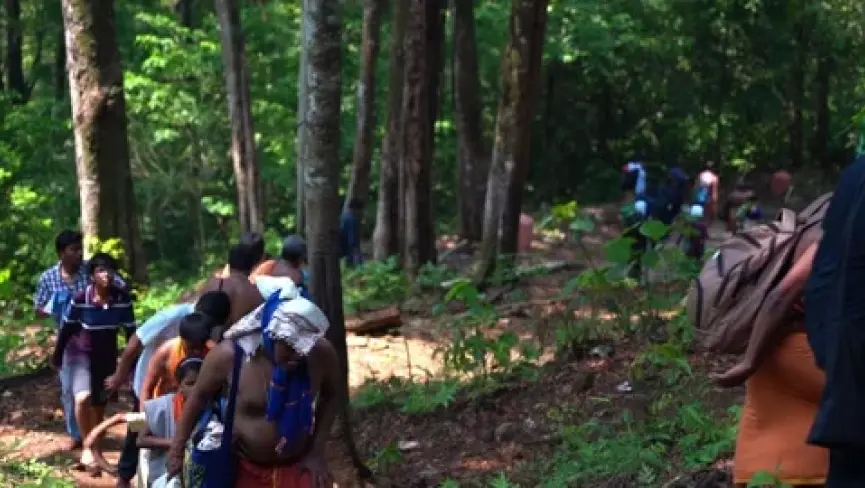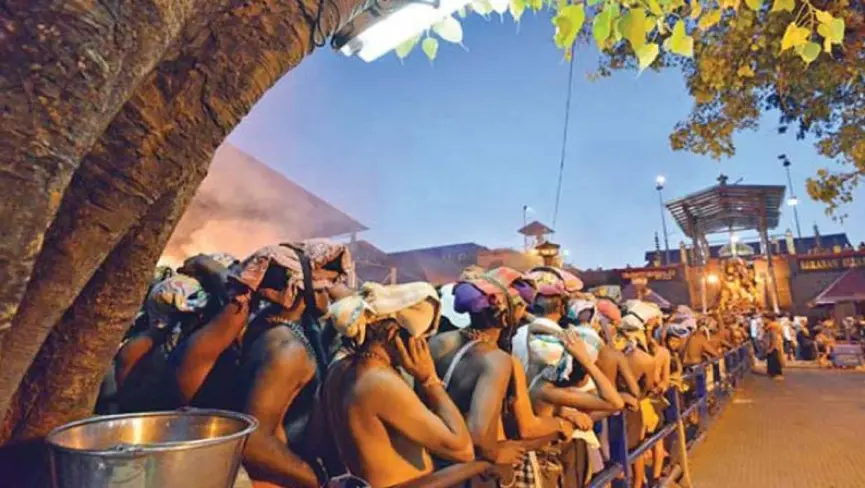
10 Essential Sabarimala Travel Tips for First-Time Ayyappa Pilgrims (2025 Guide)
Embarking on the Sabarimala pilgrimage is a deeply spiritual experience for millions of devotees of Lord Ayyappa. Nestled in the lush forests of Pathanamthitta, Kerala, this sacred journey requires both mental and physical preparation. If you’re planning your first visit, here are 10 practical travel tips to make your Sabarimala yatra smooth, safe, and spiritually fulfilling.
1. Begin Your 41-Day Vratham (Austerity) Early
2. Book Your Virtual Q (Online Darshan) in Advance
3. Choose the Right Route: Pamba, Erumeli, or Vandiperiyar
4. Carry Essential Trekking Gear
5. Respect Temple Customs and Dress Code
6. Follow Eco-Friendly Practices
7. Stay Hydrated and Eat Light
8. Plan Accommodation in Advance
9. Travel via Nilakkal Base Camp
10. Prioritize Health and Safety
1. Begin Your 41-Day Vratham (Austerity) Early
The Sabarimala pilgrimage begins long before you start your physical journey—it starts with your 41-day Vratham (austerity period). This sacred discipline is meant to purify the mind and body, preparing devotees for Lord Ayyappa’s darshan.
During the Vratham, pilgrims wear black or blue attire, avoid non-vegetarian food, alcohol, and negative habits, and lead a simple, celibate life. Daily prayers, early morning baths, and visits to temples are encouraged.
It’s also customary to carry the “Thulasi Mala” or “Rudraksha Mala” symbolizing surrender and devotion to Lord Ayyappa. Begin your Vratham early—ideally in the Mandala season (November–January)—to strengthen your discipline and spiritual focus before you start the trek to Sabarimala.
2. Book Your Virtual Q (Online Darshan) in Advance
With millions of devotees visiting Sabarimala every year, managing the crowd can be challenging. To ensure a smooth darshan experience, the Kerala Police and Travancore Devaswom Board have introduced the Sabarimala Virtual Q (Online Darshan Booking) System.
Pilgrims can register their details and select their preferred darshan date and time slot online through the official portal — sabarimalaonline.org. Early booking not only helps you avoid long waiting times but also ensures proper crowd management and safety during the Mandala–Makaravilakku season.
When booking, make sure to:
-
Enter correct ID proof details (Aadhaar, Voter ID, etc.)
-
Carry a printout or soft copy of your Virtual Q coupon during travel
-
Arrive at Pamba or Nilakkal at least two hours before your slot
By booking your Virtual Q Darshan in advance, you’ll enjoy a hassle-free and well-organized Sabarimala pilgrimage while maintaining the sacred traditions of the temple.
3. Choose the Right Route: Pamba, Erumeli, or Vandiperiyar
The path to Sabarimala Temple symbolizes the spiritual journey of a devotee — filled with challenges, devotion, and self-discovery. Choosing the right route is essential, especially for first-time Ayyappa pilgrims. Each path has its own significance, level of difficulty, and spiritual value.
1. Pamba Route (Main and Easiest Path)
The Pamba to Sannidhanam route is the most popular and convenient path for most pilgrims. It’s a 5 km uphill trek through well-maintained trails and facilities. From Nilakkal base camp, devotees can take KSRTC buses to reach Pamba, where the trek officially begins. This route is ideal for first-time and elderly pilgrims.
2. Erumeli Route (Traditional and Spiritual Path)
The Erumeli–Pamba route is considered the traditional path symbolizing Lord Ayyappa’s forest journey with his companions. Devotees perform Pettathullal, a ritual dance symbolizing the victory of good over evil, before starting this trek. It’s a longer route (about 61 km) through forests, rivers, and hills — a true test of endurance and devotion. Recommended for experienced and physically fit pilgrims.
3. Vandiperiyar Route (Scenic and Less Crowded)
The Vandiperiyar route offers a scenic journey through the forests of the Periyar Tiger Reserve. It’s less crowded and shorter than the traditional path but steeper at some points. This route is usually chosen by those seeking a quieter, nature-filled experience.
Each route provides a unique blend of spiritual significance, physical challenge, and natural beauty. Choose based on your age, fitness level, and experience — and remember, every step you take towards Sabarimala is a step toward Lord Ayyappa’s grace.
4. Carry Essential Trekking Gear
The Sabarimala trek is both a physical and spiritual challenge, winding through dense forests, steep climbs, and sometimes unpredictable weather. Preparing the right trekking gear ensures your journey is safe, comfortable, and focused on devotion rather than discomfort.
Below is a list of essential items every Ayyappa pilgrim should carry:
Basic Trekking Essentials
-
Comfortable footwear: Wear sturdy, anti-slip shoes or sandals suitable for long walks and wet terrain. Avoid new shoes to prevent blisters.
-
Light backpack: Carry only what’s necessary—keep your hands free for balance and safety.
-
Water bottle: Stay hydrated; dehydration is common on the climb. Use a steel or reusable bottle as plastic is banned.
-
Torch or headlamp: Early morning and night treks require proper lighting, especially on forest routes.
Weather & Health Gear
-
Umbrella or raincoat: Kerala’s weather can change suddenly, so protection from rain is essential.
-
First-aid kit: Include pain relievers, bandages, antiseptic, and medicines for cold, fever, or stomach upset.
-
Reusable mask or cloth: Helps against dust on crowded routes.
Food & Energy Supplies
-
Light snacks: Dry fruits, energy bars, or bananas help maintain stamina.
-
Avoid plastic packets: Carry eco-friendly pouches or containers to comply with temple rules.
Spiritual & Personal Items
-
Irumudi Kettu: The sacred bundle carried by pilgrims symbolizing devotion and offerings to Lord Ayyappa.
-
Towel and spare dhoti/cloth: For post-bath and temple use.
-
ID proof & Virtual Q ticket: Required at checkpoints and for darshan.
Proper preparation allows you to stay focused on your spiritual journey, not on physical discomfort. Pack light, stay eco-friendly, and travel with devotion in your heart — that’s the true essence of the Sabarimala yatra.
5. Respect Temple Customs and Dress Code
Visiting Sabarimala Temple is not just a physical pilgrimage but a sacred spiritual discipline. Every devotee is expected to follow certain customs, traditions, and dress codes that uphold the sanctity of Lord Ayyappa’s abode. Understanding and respecting these practices enhances your spiritual experience and shows reverence for centuries of faith and tradition.
Dress Code for Pilgrims
-
Male devotees should wear black, blue, or saffron dhotis (veshtis). These colors symbolize simplicity, surrender, and detachment from material life.
-
No shirts, T-shirts, or upper garments are allowed inside the temple premises. Men should enter bare-chested, symbolizing equality and purity before the deity.
-
Women between the ages of 10 and 50 are traditionally not permitted to enter the temple, as per the temple’s customs. However, girls below 10 years and women above 50 years are welcome.
-
Female devotees visiting within the permitted age group should wear modest traditional attire such as sarees or salwar kameez.
Temple Etiquette and Conduct
-
Maintain silence inside the temple complex and during darshan — it’s a time for prayer and reflection.
-
Avoid photography or using mobile phones inside the temple premises.
-
Do not carry or consume tobacco, alcohol, or non-vegetarian food anywhere near Sabarimala.
-
Always follow the queue system and cooperate with temple and police authorities.
-
Respect fellow pilgrims — everyone is considered equal in the eyes of Lord Ayyappa, regardless of status or background.
Spiritual Significance
The dress code and customs represent purity, humility, and discipline, helping pilgrims shed ego and worldly attachments. When you follow these traditions wholeheartedly, you align your spirit with the true purpose of the Sabarimala yatra — devotion, equality, and surrender to Lord Ayyappa.
6. Follow Eco-Friendly Practices
The sacred Sabarimala Temple is nestled deep within the Periyar Tiger Reserve, one of Kerala’s most beautiful and ecologically sensitive forest areas. As pilgrims, it’s our duty to ensure that our devotion does not harm the environment. Practicing eco-friendly habits not only preserves nature but also aligns with Lord Ayyappa’s teachings of purity, simplicity, and harmony with all beings.
Avoid Plastic Completely
The Travancore Devaswom Board has strictly banned plastic at Sabarimala. Pilgrims should avoid carrying plastic bags, bottles, or disposable items. Instead, use:
-
Reusable steel or copper bottles for water
-
Cloth or jute bags instead of plastic covers
-
Banana leaves or biodegradable plates for food
Dispose Waste Responsibly
Designated waste bins and collection points are available at Pamba, Nilakkal, and along trekking routes. Always throw waste in these bins and encourage fellow pilgrims to do the same. Keeping Sabarimala clean is a collective act of devotion.
Do Not Litter During the Trek
Many pilgrims unknowingly litter the forest trails with snack wrappers or plastic bottles. Carry a small reusable pouch for your waste and dispose of it properly after reaching the base. Leaving the path clean for others is a sign of respect for both nature and the deity.
Use Eco-Friendly Offerings
When preparing your Irumudi Kettu, avoid plastic-wrapped items. Use natural materials like cloth, bamboo, or coconut shells. The temple prefers organic and biodegradable offerings.
Support Green Initiatives
The Kerala Forest Department and Devaswom Board run multiple eco-missions during the pilgrimage season. You can participate by planting trees, volunteering for clean-up drives, or simply spreading awareness about green pilgrimage practices.
7. Stay Hydrated and Eat Light
The Sabarimala pilgrimage involves trekking through steep hills, dense forests, and long queues — all of which demand energy and endurance. To complete your journey safely and peacefully, it’s essential to stay hydrated and eat light, especially during the climb from Pamba to Sannidhanam.
Stay Hydrated Throughout the Trek
The Sabarimala climate can be humid, and the physical effort of walking several kilometers can lead to dehydration.
-
Carry a reusable steel or copper bottle (plastic is banned).
-
Sip small amounts of water regularly instead of drinking large quantities at once.
-
Avoid carbonated drinks or bottled beverages sold outside the official premises.
-
Refill your bottle at safe water kiosks or annadanam centers along the route.
Proper hydration prevents fatigue, headaches, and muscle cramps — helping you stay focused on your prayers and devotion.
Eat Light, Sattvic Food
During the 41-day vratham and the pilgrimage, devotees are encouraged to eat sattvic food — simple, vegetarian meals that promote purity and calmness.
-
Prefer rice, fruits, vegetables, and boiled food over spicy or oily meals.
-
Avoid heavy or processed foods before and during the trek.
-
Eat small portions to maintain energy without feeling bloated or tired.
Take Advantage of Annadanam Centers
Several Annadanam (free meal) centers run by devotees and temple boards provide nutritious vegetarian food along the route. These meals are clean, balanced, and prepared in a spiritually pure atmosphere. Accepting annadanam is considered an act of humility and grace.
Avoid Overeating Before Darshan
Many first-time pilgrims eat heavily after reaching Pamba or Nilakkal, which can cause discomfort during the uphill climb. Instead, have a light meal and carry a few energy snacks like bananas or dry fruits to eat as needed.
8. Plan Accommodation in Advance
Proper accommodation planning is one of the most important steps in ensuring a smooth and comfortable Sabarimala pilgrimage, especially during the peak Mandala–Makaravilakku season (November to January). With millions of devotees arriving from across India, finding a place to stay can be difficult without prior arrangements.
Accommodation Options for Pilgrims
Pilgrims can stay at three main locations based on convenience and budget:
-
Nilakkal Base Camp – The main parking and transit hub for pilgrims.
-
Offers temporary shelters, dormitories, and paid rooms managed by the Travancore Devaswom Board (TDB).
-
Facilities include toilets, water, food stalls, and medical aid.
-
Ideal for families and first-time visitors who prefer easy transport access.
-
-
Pamba – The traditional starting point of the Sabarimala trek.
-
Offers basic lodges, dormitories, and tents for overnight stays.
-
Best suited for pilgrims planning an early morning trek to Sannidhanam.
-
-
Sannidhanam – The temple hilltop area near Lord Ayyappa’s shrine.
-
Limited temple guest houses, pilgrim shelters, and resting halls are available.
-
Prior booking is mandatory due to high demand.
9. Travel via Nilakkal Base Camp
During the Sabarimala pilgrimage season, managing traffic and ensuring safety for millions of pilgrims is a major challenge. To make the journey smoother, the Travancore Devaswom Board (TDB) and Kerala Police have established Nilakkal Base Camp as the main transit and parking hub for all vehicles heading to Sabarimala.
Whether you are traveling by car, bus, or van, Nilakkal is your mandatory starting point for the final leg of the yatra.
Why Nilakkal is Important
Nilakkal Base Camp acts as the logistics and control center for the entire pilgrimage.
-
Private vehicles are not allowed beyond Nilakkal during the main pilgrimage season to reduce congestion and environmental impact.
-
Devotees must park their vehicles at the designated Nilakkal parking area, which can accommodate thousands of cars and buses.
-
From Nilakkal, you’ll take special KSRTC shuttle buses that operate 24/7 to Pamba, the traditional starting point of the Sabarimala trek (about 18 km away).
Nilakkal to Pamba Shuttle Service
The Kerala State Road Transport Corporation (KSRTC) provides frequent, affordable, and safe bus services between Nilakkal and Pamba.
-
Bus fare: Around ₹50–₹100 per person (subject to season).
-
Frequency: Every few minutes during peak hours.
-
Duration: Approximately 30–40 minutes, depending on traffic and weather.
These official buses are the only authorized mode of transport beyond Nilakkal, ensuring safety and environmental protection inside the forest area.
Facilities at Nilakkal Base Camp
Nilakkal offers all the necessary facilities for pilgrims to rest and prepare before continuing the journey:
-
Spacious parking area for cars, buses, and two-wheelers
-
Toilets, drinking water, and restrooms maintained by Devaswom Board
-
Accommodation, restaurants, and medical centers
-
Police and security help desks for assistance
-
Shops selling pooja items, essentials, and food
You can also rest overnight at Nilakkal if you arrive late or want to start your trek early the next morning.
10. Prioritize Health and Safety
The Sabarimala pilgrimage is both a spiritual and physical challenge. Pilgrims trek through dense forests, steep paths, and large crowds — all of which require preparation and awareness. Prioritizing your health and safety ensures a peaceful and fulfilling darshan of Lord Ayyappa without unnecessary stress or risk.
Consult a Doctor Before the Pilgrimage
If you have existing health conditions such as hypertension, diabetes, asthma, or heart problems, consult your doctor before beginning the 41-day Vratham or the trek.
-
Get a basic health check-up to assess your fitness level.
-
Carry prescribed medicines and a first-aid kit with essentials like bandages, pain relievers, and antiseptic.
-
Avoid strenuous treks if advised by a doctor — choose lighter routes or shorter distances.
Trek Safely and Pace Yourself
The Pamba to Sannidhanam trek (about 5 km) can be physically demanding, especially for first-time pilgrims.
-
Walk at a steady, comfortable pace; don’t rush.
-
Take short breaks to rest your legs and hydrate frequently.
-
Use walking sticks or trek poles if needed for balance.
-
Avoid overcrowded paths or shortcuts that bypass the official trail.
Remember: the pilgrimage is not a race, but a journey of devotion and endurance.
Stay Clean and Hygienic
Sabarimala attracts lakhs of devotees every day, so maintaining hygiene is essential.
-
Wash your hands before meals and after using restrooms.
-
Use only clean drinking water from authorized sources.
-
Carry a small sanitizer, towel, and extra mask for personal care.
-
Avoid bathing in unsafe river spots; use designated bathing areas at Pamba.
Good hygiene keeps you healthy and prevents infections during the yatra.
Follow Safety Guidelines and Instructions
The Kerala Police, Forest Department, and Devaswom Board have set up multiple help centers and checkpoints for your safety.
-
Always follow their instructions, especially regarding crowd control and restricted zones.
-
In case of emergencies, approach the medical centers or help desks at Nilakkal, Pamba, or Sannidhanam.
-
Keep your Virtual Q coupon and ID proof handy for verification.
Avoid carrying prohibited items like fireworks, weapons, or alcohol — they are strictly banned and disrespect the sanctity of the pilgrimage.


